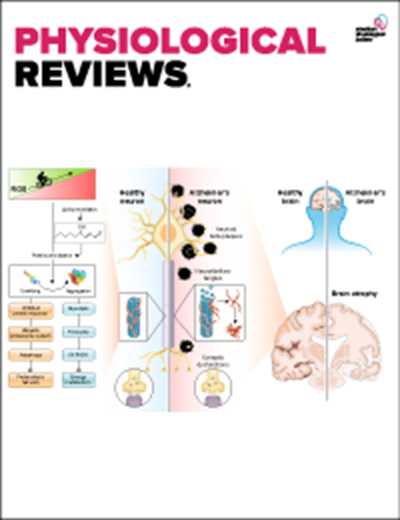Frontiers in the physiology of male pattern androgenetic alopecia: Beyond the androgen horizon.
IF 28.7
1区 医学
Q1 PHYSIOLOGY
引用次数: 0
Abstract
Male pattern androgenetic alopecia (mpAGA), the most common form of hair loss in men, represents a heritable, androgen-dependent complex trait distinct from female pattern hair loss. Despite the psychosocial burden of mpAGA in some affected individuals and associations with other morbidities, we portray mpAGA as an essentially physiological phenomenon in which defined hair follicle (HF) populations in developmentally preprogrammed scalp skin regions undergo a dramatic, but reversible (mini-)organ transformation in genetically predisposed individuals. Histologically, mpAGA exhibits progressive HF miniaturization (terminal-to-vellus conversion) and anagen shortening. Clinically, this results in a characteristic balding pattern of frontotemporal and vertex scalp skin, associated with telogen effluvium. It remains unclear how exactly androgens induce this phenotype, since neither androgen receptor polymorphisms nor changes in androgen serum or local androgen skin levels persuasively explain it. It also is as yet unresolved if mpAGA-associated HF transformation and hair cycle changes are primarily driven by the HF mesenchyme, e.g. by excessive emigration and/or reduced inductive potential of dermal papilla fibroblasts, or by intraepithelial events such as prostaglandin D2-dependent reduced HF epithelial stem cell progenitor generation. While critically revisiting our limited current understanding of mpAGA physiology and the role of mpAGA-associated genes we discuss potential targets for future therapeutic intervention beyond androgens and highlight selected dysregulated signaling pathways in mpAGA. We underscore mpAGA as an instructive, accessible model for interrogating under-investigated physiological roles of immune cells, oxidative stress, aging/senescence, and the microbiome in human organ remodeling and hair cycle regulation, and define major open research questions beyond androgen receptor- mediated signaling.男性型雄激素性脱发的生理学前沿:超越雄激素水平。
男性型雄激素性脱发(mpAGA)是男性最常见的脱发形式,是一种可遗传的、雄激素依赖性的复杂特征,与女性型脱发不同。尽管mpAGA对一些受影响的个体造成心理社会负担,并与其他疾病有关,但我们将mpAGA描述为一种本质上的生理现象,在这种生理现象中,发育预先编程的头皮皮肤区域的定义毛囊(HF)群体在遗传易感个体中经历了戏剧性的,但可逆的(微型)器官转化。组织学上,mpAGA表现出进行性HF小型化(终末到肌腱转化)和生长原缩短。临床上,这导致前额颞部和头皮顶点皮肤的特征性秃顶,并伴有休止期积液。目前尚不清楚雄激素究竟是如何诱导这种表型的,因为雄激素受体多态性、雄激素血清或局部雄激素皮肤水平的变化都不能令人信服地解释它。此外,mpaga相关的HF转化和毛发周期变化是否主要由HF间质驱动,例如,真皮乳头成纤维细胞的过度迁移和/或诱导电位降低,或上皮内事件,如前列腺素d2依赖性的HF上皮干细胞祖细胞生成减少,目前尚不清楚。在批判性地回顾我们目前对mpAGA生理学和mpAGA相关基因作用的有限理解的同时,我们讨论了除雄激素外未来治疗干预的潜在目标,并强调了mpAGA中选择的失调信号通路。我们强调mpAGA是一个指导性的、可访问的模型,用于询问免疫细胞、氧化应激、衰老/衰老和微生物组在人体器官重塑和头发周期调节中的生理作用,并定义了雄激素受体介导的信号传导之外的主要开放研究问题。
本文章由计算机程序翻译,如有差异,请以英文原文为准。
求助全文
约1分钟内获得全文
求助全文
来源期刊

Physiological reviews
医学-生理学
CiteScore
56.50
自引率
0.90%
发文量
53
期刊介绍:
Physiological Reviews is a highly regarded journal that covers timely issues in physiological and biomedical sciences. It is targeted towards physiologists, neuroscientists, cell biologists, biophysicists, and clinicians with a special interest in pathophysiology. The journal has an ISSN of 0031-9333 for print and 1522-1210 for online versions. It has a unique publishing frequency where articles are published individually, but regular quarterly issues are also released in January, April, July, and October. The articles in this journal provide state-of-the-art and comprehensive coverage of various topics. They are valuable for teaching and research purposes as they offer interesting and clearly written updates on important new developments. Physiological Reviews holds a prominent position in the scientific community and consistently ranks as the most impactful journal in the field of physiology.
 求助内容:
求助内容: 应助结果提醒方式:
应助结果提醒方式:


